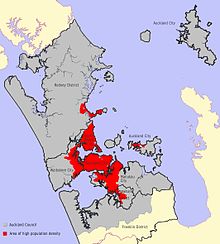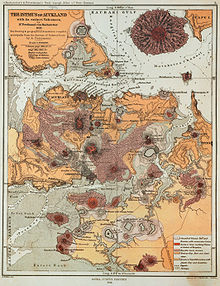Auckland
![]()
The title of this article is ambiguous. For other meanings, see Auckland (disambiguation).
Auckland [ˈɔːklənd], official name Auckland Council, in Māori: Tāmaki Makaurau or Ākarana, is a major city and Unitary Authority on the North Island of New Zealand. With a population of just over 1.4 million, it is the largest city in New Zealand, home to about one-third of New Zealand's population. The Māori name Tāmaki Makaurau means "A young beauty with 100 lovers", while Ākarana is a version of "Auckland" adapted to the Māori phonetic system.
The landscape of multicultural Auckland is shaped by 53 inactive volcanoes, between which the city stretches. The city has them to thank for its extensive parks, which extend right into the city centre. The location at protected sea bays also contributes significantly to the image of Auckland, not least through the numerous sailboats, which earned the city the nickname City of Sails.
On November 1, 2010, the Auckland Council was formed from the Greater Auckland Metropolitan Area, comprising the previously administratively independent cities of Auckland City, Manukau City, North Shore City and Waitakere City, the districts of Franklin District, Papakura District and Rodney District, and the Auckland Regional Council, which, as planned, is to solve the problems of the Greater Auckland Metropolitan Area from a unified and centrally organized administrative structure. The Auckland Council was politically legitimised by a local election on 9 October 2010 and since then has combined all previous administrative units under the government of a mayor and 20 councillors.
Auckland ranked third in a 2018 ranking of cities with the highest quality of life in the world.

Map section of the urban area of the Auckland Council (shown in grey, red with high population density)
Name origin
The city of Auckland was given its name in 1840 by the then Governor William Hobson, who named it in honour of Lord Auckland, from whom Hobson had been given command of the frigate H.M.S. Rattlesnake. Lord Auckland was the first Lord of the British Admiralty at the time, and Governor-General in India from 1835 to 1842. A statue was erected in his honour in Calcutta in 1848, which was presented to the City of Auckland in 1969 as a gift from the West Bengal State Government, where it was erected in front of the Civic Centre building.
Geography
Geographical position
Auckland is located on the 380 km long and up to 80 km wide northern headland of the North Island of New Zealand. The city area borders the Northland region to the north and the Waikato region to the south. In the west the Tasman Sea forms the natural border and in the east the Pacific Ocean, whereby the islands Great Barrier Island and the islands lying between it and Auckland and the sea area of the Hauraki Gulf also belong to the urban area. The so 2010 newly formed urban area covers a land area of 4938 km².
The highest elevation in the city area is the 688 m high Kohukohunui, which is located in the Hunui Ranges in the far southeast of the city. Another mountain range lies to the west of the city centre on the west coast. The Waitākere Ranges rise to 474 m there. The land area of Auckland narrows in the middle of the north-south extension to a few kilometers, because from the west the Manukau Harbour and from the east the Waitemata Harbour and the wide estuary of the Tamaki River protrude into the city area.
Geology
Large parts of New Zealand are under the direct influence of the Pacific Ring of Fire, including the area in and around Auckland. The city was built on a volcanic field consisting of basalt, the Auckland Volcanic Field. This consists of 53 volcanoes that are no longer active. They shaped the landscape in that they either rose out of the sea as islands or formed hills, lakes or lagoons. The first eruptions began about 60,000 to 140,000 years ago, while the last two major eruptions, about 550 and 600 years ago, formed the largest surviving volcano, Rangitoto, off the east coast of the city (see map). Rangi means "sky" and Toto "blood", suggesting that the island got its name from Māori who lived to see the last eruption. Even today, because of the highly acidic soil, few birds and insects live on this island, which is mainly overgrown with plants that have been able to adapt to the black, stony soil.
Many of the other former volcanoes were eroded or their surface structure was heavily modified in order to create space for flat buildings or parks. Even today, numerous hills and terraces can be seen in the landscape, indicating the volcanoes. In recent years, various district administrations have been lobbying the New Zealand government to place the unique scenic and cultural diversity of the volcanoes on the country's tentative list of UNESCO World Heritage Candidates.
Climate
Auckland is under the influence of a subtropical oceanic climate. The temperature fluctuations throughout the year are small. The climate is characterised by long warm, humid summers and cooler, fairly wet winters. Average January temperatures vary between 24 °C and 30 °C, with February often warmer still, while average high temperatures in July range from 14 °C to 20 °C. On average, there are 2100 hours of sunshine in Auckland each year. Although there is already more rain in the summer months than in Wellington or Christchurch, for example, most of the precipitation falls in the winter months. The average annual precipitation is over 1243 mm.
The wind usually comes from a westerly to southwesterly direction, but northeasterly winds are not uncommon.
Although the city's climate is heavily dependent on geographical points such as hills, sea or air currents, the temperature rarely exceeds 35 °C. On 27 July 1939, Auckland recorded its only officially confirmed snowfall, although snow is not uncommon for various places in the country, especially in the South Island, for example Christchurch, where it regularly reaches sea level. Overall, Auckland is considered New Zealand's most climatically mild major city.
| Monthly average temperatures and precipitation for Auckland
Source: Data basis: monthly averages from 1961-1990 | |||||||||||||||||||||||||||||||||||||||||||||||||||||||||||||||||||||||||||||||||||||||||||||||||||||||||||||||||||||||||||||||||||||||||||||||||||||||||||||||||||||||||||||||||||||||||||||||||||||||||||||||||||||||||||||||||||||||||||||||||||||||||||||||||||||||||||||||||||||||||||||||||||||||||

Geological map showing the area around Auckland and its extinct volcanoes from the first systematic geological mapping of the country by Ferdinand von Hochstetter
Search within the encyclopedia